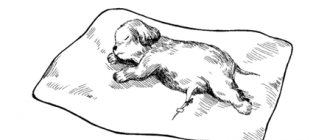Every pug owner has thought about getting puppies from their pet at least once in their life, but it is important to consider that there are many nuances behind such a delicate matter.
You need to take into account not only the age and health of your dog, but also weight, height, character, suitable days for mating, place, choice of a mate and, of course, your readiness - both financial and moral.
Therefore, as soon as you have made such a decision, remember that absolutely all responsibility for the dog and its future puppies falls entirely on your shoulders. And if you are not entirely confident in your abilities, you can always turn to a professional puppy breeding instructor for help, who will competently supervise such a complex process.
When and at what age can you breed a dog?
For the first time, pugs come into heat at the age of 6 to 10 months, but you cannot start breeding at such an early age - you need to let the pet become physically and mentally stronger.
The first mating should take place no earlier than 15 months for a female and 12 months for a male. This information cannot be ignored, since pregnancy at this age is not the most favorable factor and can have a detrimental effect on the health of your pet.
At 10 months, the dog looks quite mature in appearance, but its joints and muscles are not yet fully developed and there is a risk that the young pug’s growth may stop, its back will become depressed, and the animal will also receive psychological trauma and rejected puppies. As a result, such a dog can no longer be used to reproduce offspring.
Caring for a dog during heat
To prepare your pug for a future pregnancy, you need to be able to provide proper care for him. To do this, any dog breeder should consider some basic points:
- When walking, it is better if the bitch is on a leash. Even if at normal times she is calm and pliable, during the period of heat it is quite difficult to cope with her;
- To prevent your pet from becoming pregnant too early, you should keep her away from male dogs;
- Sometimes your pug's heat may start at the wrong time. For example, you are going to an exhibition or a festival. Please remember that such activities should be avoided at this time. Firstly, you can suddenly lose control over the animal, and an unwanted mating will occur. Secondly, the dog is very aggressive during this period, so it will be much more difficult for you to cope with it.
Delivering babies to pugs after their first heat is not a good plan. To lead to early pregnancy means to create a dangerous situation for the health of the pet. First, learn how to provide high-quality care for your dog, wait until she is at least 15 months old, and only then prepare for the pug’s mating and childbirth.
Similar article: How to name a boy or girl pug
On what day of heat should I take my pug?
One of the most pressing questions for dog owners. On the one hand, days 10-14 are considered ideal, but on the other hand, do not forget that each organism has its own characteristics, so do not rush to rush to mating. Conclusion: there are no correct days; you need to monitor your pet individually.
You need to monitor the progress of the estrus and the behavior of the bitch immediately from the first estrus, and not when you are about to take her for mating. You can do an experiment and (with the owner’s consent) bring her to a male dog. Next, we observe the dog’s reaction.
If he growls/snarls/is afraid, then it’s too early (the behavior is typical for the first days of estrus). If he flirts, but does not allow the male to jump on him, then ovulation is approaching and you need to be on guard. Retracts the tail, bends the back, places a loop, then the next 2-3 days will be suitable for mating.
It happens that a bitch is aggressive towards males throughout her entire heat. What to do in this situation? You need to observe her physical changes:
- frequent urination;
- disobedience;
- attempts to escape;
- overly aggressive or playful behavior;
- intense shedding;
- here we introduce softening, as well as an increase in the loop and a change in the color of the discharge - instead of bloody discharge, lighter, pinkish discharge appears.
But we cannot rely only on the last factor. It happens that during estrus there is practically no blood and owners often miss its onset.
IMPORTANT: pugs usually come into heat twice a year, but they can bear puppies no more than once every 1.5-2 years.
Choosing a Healthy Couple
The choice of a couple must be approached no less responsibly than the process itself. After all, the health of both partners determines how the future offspring will turn out.
Future parents can be analyzed by participating in exhibitions and being assessed by various experts who will help identify shortcomings that are often found in almost every dog. And based on the identified defects that are inherent in the parents (if any), it is possible to draw up the desired portrait of future children.
But do not forget that there are certain taboos under which you should never breed puppies:
- the dog is not a purebred pug, but only vaguely resembles this breed;
- the dog has genetic diseases or serious anatomical defects (the most common: aseptic necrosis of the femoral head, necrotizing meningoencephalitis, inflammation of the uterus, brachycephalic syndrome);
- the dog has undergone complex surgical interventions or serious injuries;
- the dog has problems with the cardiovascular system;
- the dog is sick/weak/has problems with excess weight;
- The dog is too large or too small for this breed.
If your pet or its partner fits at least one of these points, then you should not resort to mating.
How to choose a healthy pair for a girl to breed with?
- To breed pugs, you need to worm them. For a female dog it is carried out before the onset of estrus, for a male dog - 4 times a year without fail.
- Also, before mating, pugs need to undergo blood tests.
- It is prohibited to mate pure breeds with mongrels or other breeds.
- It is necessary to monitor the weight of pets, especially for females. Excess weight can lead to pregnancy failure or complications in the future.
- Dogs with genetic disorders and diseases of the cardiovascular system should be excluded.
- Pugs with anatomical defects are also unsuitable for breeding, even if they have a pedigree.
- Dogs with serious illnesses or surgical procedures are also excluded.
- If the female has problems with the reproductive system, then they need to be eliminated before breeding.
Preparation for mating
Preparation must begin three months before the heat. Before going into heat, you need to undergo a preventive examination by a veterinarian, take blood and stool tests for eggworms, cure existing inflammations, and also make sure that all necessary vaccinations are completed on time.
A month before mating, you need to carry out deworming and rid your pet of fleas. If you are late with anthelmintic drugs, this threatens the resorption of embryos in the early stages or the loss of offspring at 4-5 weeks of pregnancy.
For a male dog, you need to undergo a preventive examination by a veterinarian and undergo tests once every six months. Treat for fleas no later than a week before mating, and deworming is carried out as usual (once every 3-4 months). But if the analysis shows the presence of worms, then the problem must be eliminated immediately before mating.
Another important point for both parents is weight control, because Pugs have a tendency to become obese. For a bitch, being overweight does not threaten pregnancy and complications in the future, but it will be difficult and uncomfortable for a dog to climb on top of a girl, he will be out of breath and get tired faster.
Therefore, it is worth unloading animals from excess fat prematurely and this requires only a balanced diet and moderate physical activity.
Pairing Instructions
Make sure the animals are as comfortable as possible. If mating occurs in the summer, then it is better to prescribe it in the morning or evening.
Animals (especially males) need to be given a good walk 2 hours before crossing so that they become more loving and do not need to be fed.
The mating itself should be carried out on the male’s territory so that he feels more confident, especially if he has little experience in amorous matters.
It is also advisable to have an experienced breeder present who can professionally monitor the process and help if difficulties arise.
When the animals become comfortable, a period of courtship and flirtation begins, which is the beginning of sexual intercourse. The male will carefully sniff the female’s intimate place, as he is excited by this smell, and the female will allow him to lick the loop and then begin mating.
But sometimes not everything goes smoothly: the bitch can become nervous, afraid, or behave aggressively and not let the male near. In this case, you or the breeder will have to intervene.
It will be necessary to carry out the mating on a non-slip table, holding the pug by the front paws. If necessary, use anti-bite gloves if the female is very aggressive, and a muzzle, but only as a last resort, because this can humiliate the dog.
If the female is larger than the gentleman, then a special stand or a thick book can be placed on his hind legs. You may need to hold the female's rear and adjust the position of her loop.
After this process is completed, the male will turn in the opposite direction (if necessary, help him) and the genitals of the animals will remain in the “lock” for 10-15 minutes.
Bonding may take up to an hour or more, but this is not a reason to worry, since in this position the process of fertilization of the egg occurs.
Mating may not work out right away, so to be on the safe side, it is recommended to repeat the mating the next day after the first time in order to consolidate the result, but do not forget to give the animals rest so as not to overtire them.
What to do after
Within a month after mating, you can determine whether the dog is pregnant or not. Her behavior changes, the female becomes lethargic, begins to sleep and eat more, gains weight, and there is a rare urge to urinate.
According to these signs, offspring are expected in 2 months, but to find out for sure, you should contact a veterinary clinic (the visit is scheduled for 6-7 weeks after mating). There the dog will undergo an ultrasound and will be provided with all the necessary recommendations for pregnancy management.
Pregnancy and childbirth
Pug pregnancy indicators are:
- Lethargy.
- Rare urge to urinate.
- Frequent sleep.
- Increased appetite.
- Weight gain.
But to make sure your pet is pregnant, you need to do an ultrasound 6-7 weeks after mating. Pregnancy in this dog breed lasts approximately 60 days. From 2 to 5 puppies can be born, but sometimes 7 small pets are born.
During pregnancy, pugs should include the following in their diet:
In the first month of pregnancy, toxicosis may occur. During this period, you should reduce your walks and remove meat and fish from your diet. A week before giving birth, you need to measure your temperature 2 times a day, since during the delivery process the temperature drops to 36.6-36.8. The day before giving birth, the dog becomes restless, begins to starve and asks for more attention.
Before labor begins, you need to prepare:
- clean rags;
- processed scissors;
- water;
- heating pad;
- brilliant green;
- puppy box.
After your pet has given birth, you need to:
- Cut off the umbilical cord. She will not be able to do this on her own due to the structure of her teeth and respiratory system, so after the pulsation stops, she needs to be trimmed with scissors.
- The puppy needs to be picked up, wiped with a dry cloth and placed on the mother's nipple for 20 minutes so that he can take a sip of mother's milk.
- After the birth is over, the dog needs to be fed, bathed in warm water and sent to its children.
Common mistakes
Unfortunately, due to inexperience and worries about his pet, the owner is not always able to avoid mistakes that can negatively affect the animal in the future.
- In addition to the fact that you cannot breed dogs that are too young or too old, you also cannot force animals towards each other, so as not to intensify the stressful situation even more. It's better to give them time to get to know each other and play with each other.
- During the act itself, the female can and sometimes needs to adjust the noose, but under no circumstances should she touch the male’s genitals, as this will scare him away and he will not want to cover the female. While the animals are in the “castle”, they should not be allowed to squirm around - this is fraught with adverse consequences and injuries.
- Even after the pugs come unglued from each other, dog owners think that the work is completed, but the most important moments remain ahead. After intercourse, you need to put the girl on her back, raise the back of her body so that the sperm flows deeper. In addition, you should not let her pee earlier than two hours after mating.
- As for our champion, as a precaution after mating, his genitals need to be treated with Miramistin. If this procedure is neglected, various infections can enter the dog’s body.
- During pregnancy, also try to give your dog special attention and proper care: walk a lot, monitor nutrition and well-being, do not neglect going to the veterinarian if you notice strange changes in the behavior of the animal or in itself, because an advanced disease or even an innocent infection can tragically affect future offspring and the dog as a whole.
The main mistakes of breeders
What's so special about breeding dogs? How many dogs reproduce on their own? What problems might arise? But pugs have problems with their offspring, and they often happen due to the fault of the breeders.
Breeding pugs can be complicated for several reasons:
- Excess weight;
- Behavior, character;
- Anatomical features (height, accessibility of genital organs, age).
When breeding pugs, breeders should be aware of the following:
- Trauma or surgery;
- The dog has deviations from the standards (anatomical);
- There are genetic abnormalities;
- Problems with the cardiovascular system;
- Pathologies of the reproductive system;
- Temperament.
If your pug has any of the above, then mating should not be carried out.
What to do if it doesn't work out
First of all, you don’t need to get upset and under no circumstances scold the dog. In animals, like humans, the fertilization process is not always successful and this is normal.
It is important to soberly assess the situation, analyze the entire mating period, the mistakes made and try to prevent them next time.
But you shouldn’t discount the rather sad option of infertility of your dog or its partner, the cause of which could be congenital pathologies of the internal genital organs, acquired diseases, or even psychological problems.
Is it possible without a lock?
“Castle” is a physiological feature of all animals of the canine family. It lies in the fact that after ejaculation, the genital organs of both dogs increase in size and swell, which is why the animals temporarily appear to be connected to each other.
You should not be afraid of this phenomenon, since it does not pose any danger to dogs. On the contrary, if there was no “lock” during mating, this is a reason to suspect that something went wrong: either the bitch is not ready, or one of the partners has a pathology of the genital organs that prevents the formation of a “lock”.
However, there are also animals that mate quite successfully without forming a “lock.” These are their individual characteristics, which in no case should be considered the norm for all other pugs.
Important! If the “lock” did not work, then you can hold the dog during mounting for 10-15 minutes, not allowing him to get off the bitch. In this case, mating even without a “lock” can be quite effective.










